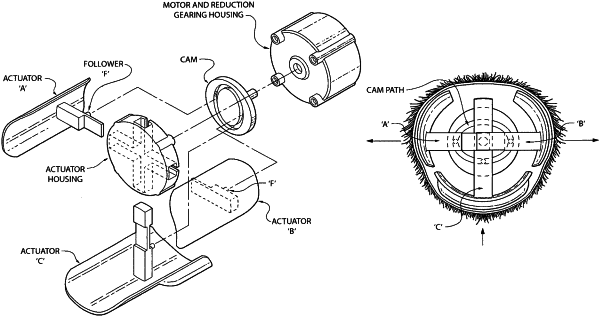| CPC A63H 3/001 (2013.01) [A63H 3/02 (2013.01); G09B 23/28 (2013.01); A63H 2200/00 (2013.01)] | 15 Claims |

|
1. An respiratory regulation apparatus comprising:
a CPU housing including a processor programmed to execute instructions to provide one or more control signals to control one or more components of the apparatus;
a first actuator that includes a first actuator extension having a first follower;
a second actuator that includes a second actuator extension having a second follower;
an actuator housing that includes a first actuator housing receiving slot that receives the first actuator extension and a second actuator housing receiving slot that receives the second actuator extension; and
a slotted cam that connects to a shaft of a motor that is configured to rotate the cam in a first rotational direction, the slotted cam including a continuous oval slot that receives the first follower and the second follower,
the processor providing one or more of the control signals to control the rotational speed of the motor shaft such that the cam rotates in the first rotational direction at a first rotational speed that causes the first actuator extension to move inward and outward within the first actuator housing receiving slot in a repeating pattern at an actuator movement rate based on the rotational movement of the cam in the first rotational direction and the second actuator extension to move inward and outward within the second actuator housing receiving slot in a repeating pattern at the actuator movement rate based on the rotational movement of the cam in the first rotational direction,
wherein the processor dynamically controls the rotational speed of the motor shaft such that the cam rotates in the first rotational direction at dynamically decreasing rotational speeds that result in the first and second actuators moving inward and outward within the respective first and second actuator housing receiving slots at dynamically decreasing actuator movement rates.
|